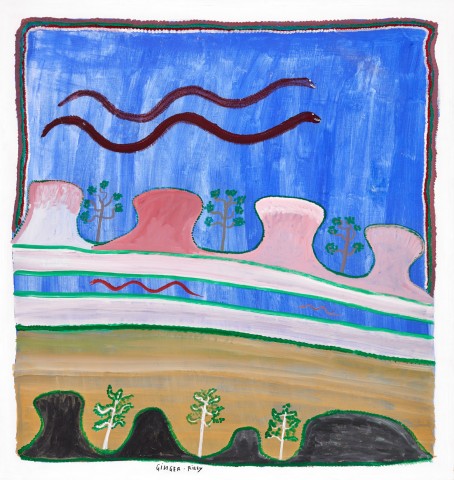LIMMEN BIGHT COUNTRY, 1992
GINGER RILEY MUNDUWALAWALA
synthetic polymer paint on linen
153.0 x 143.5 cm
signed lower centre: GinGER RiLEY
bears inscription verso: artist’s name, title and Alcaston Gallery cat. AK1956
Anthony W. Knight, Melbourne
Alcaston Gallery, Melbourne
Private collection, Melbourne
Colour Country: Art from Roper River, Wagga Wagga Art Gallery, New South Wales, 5 June – 2 August 2009; Flinders University Art Museum, Adelaide, 4 December 2009 – 14 February 2010; Drill Hall Gallery, Canberra, 25 February – 11 April 2010; Museum and Art Gallery of the Northern Territory, Darwin, 22 May 2010 – 12 July 2010
Bowdler, B., Colour Country: Art from Roper River, Wagga Wagga Art Gallery, New South Wales, 2009, pp. 8 (illus.), 91
‘My mother’s country is in my mind.’1
Distinguished by their daring palette, dynamic energy and strongly flattened forms, Riley’s bold, brilliantly coloured depictions celebrating the landscape and mythology of his mother’s country are admired among the finest in contemporary Indigenous art. Emerging at a time when barks were the familiar output for his Arnhem Land country and Papunya Tula paintings were considered the norm, his striking interpretations not only challenged, but irrevocably changed, preconceived notions of Indigenous art – thus earning him the moniker ‘the boss of colour’ by artist David Larwill. Notably influential upon such idiom was Riley’s chance encounter during his adolescence with celebrated watercolourist Albert Namatjira, whose non-traditional aesthetic and concept of ‘colour country’ left an indelible impression upon the young artist. Encouraged by ‘…the idea that the colours of the land as seen in his imagination could be captured in art with munanga (white fella) paints’,2 it was not, however, until three decades later that Riley would have the opportunity to fully explore his talent when the Northern Territory Open College of TAFE established a printmaking workshop in the Ngukurr Aboriginal Community (formerly known as the Roper River Mission). Notwithstanding his mature age of 50, Riley rapidly developed his own highly sophisticated style and distinct iconography and, after initially exhibiting with the other Ngukurr-based painters, soon established an independent career at Alcaston Gallery. Enjoying tremendous success both locally and abroad over the following sixteen years before his untimely death in 2002, Riley received a plethora of awards including the inaugural National Heritage Commission Aboriginal and Torres Strait Islander Art Award in 1993 and an Australia Council Fellowship in 1997 – 98, and in 1997, was the first living indigenous artist to be honoured with a retrospective at the National Gallery of Victoria, Melbourne.
Capturing the saltwater area extending from the coast of the Gulf of Carpentaria along the Limmen Bight River to the weather-worn rocky outcrops known as the ‘Four Arches’, Limmen Bight River, 1992 offers a stunning example of Riley’s heroic landscapes. Pivotal to the composition is Garimala, the mythological Taipan who, according to the ancestral dreaming, created the Four Arches – an area regarded as ‘…the centre of the earth, where all things start and finish’3 – and lives in the waterhole nearby. Here the mythological serpent is depicted as a pair of snakes (a typical convention to denote his travelling), while the Four Arches are envisaged in multiple, emphasising their significance and reflecting different viewpoints – in the foreground riverside, as dark rounded rocks, and in the middle ground as pink towers, with vegetation atop. Significantly, such aerial overview is informed by the artist’s strong sense of place; as Riley observes, he often paints ‘…on a cloud, on top of the world looking down… In my mind, I have to go up to the top and look down to see where I’ve come from, not very easy for somebody else, but all right for me. I just think in my mind and paint from top to bottom, I like that’.4
A vibrant celebration of the joy of belonging to the saltwater country of the Mara people, indeed the work embodies Riley’s powerful vision of his mother’s country as a mythic space – a mindscape whose kaleidoscope of dazzling colours and icons continually evoke wonder and mystery in the viewer with each new encounter.
1. Riley cited in Ryan, J., Ginger Riley, National Gallery of Victoria, Melbourne, 1997, p. 15
2. Riley cited ibid.
3. Riley, ibid., p. 29
4. Riley, ibid., p. 27
VERONICA ANGELATOS
